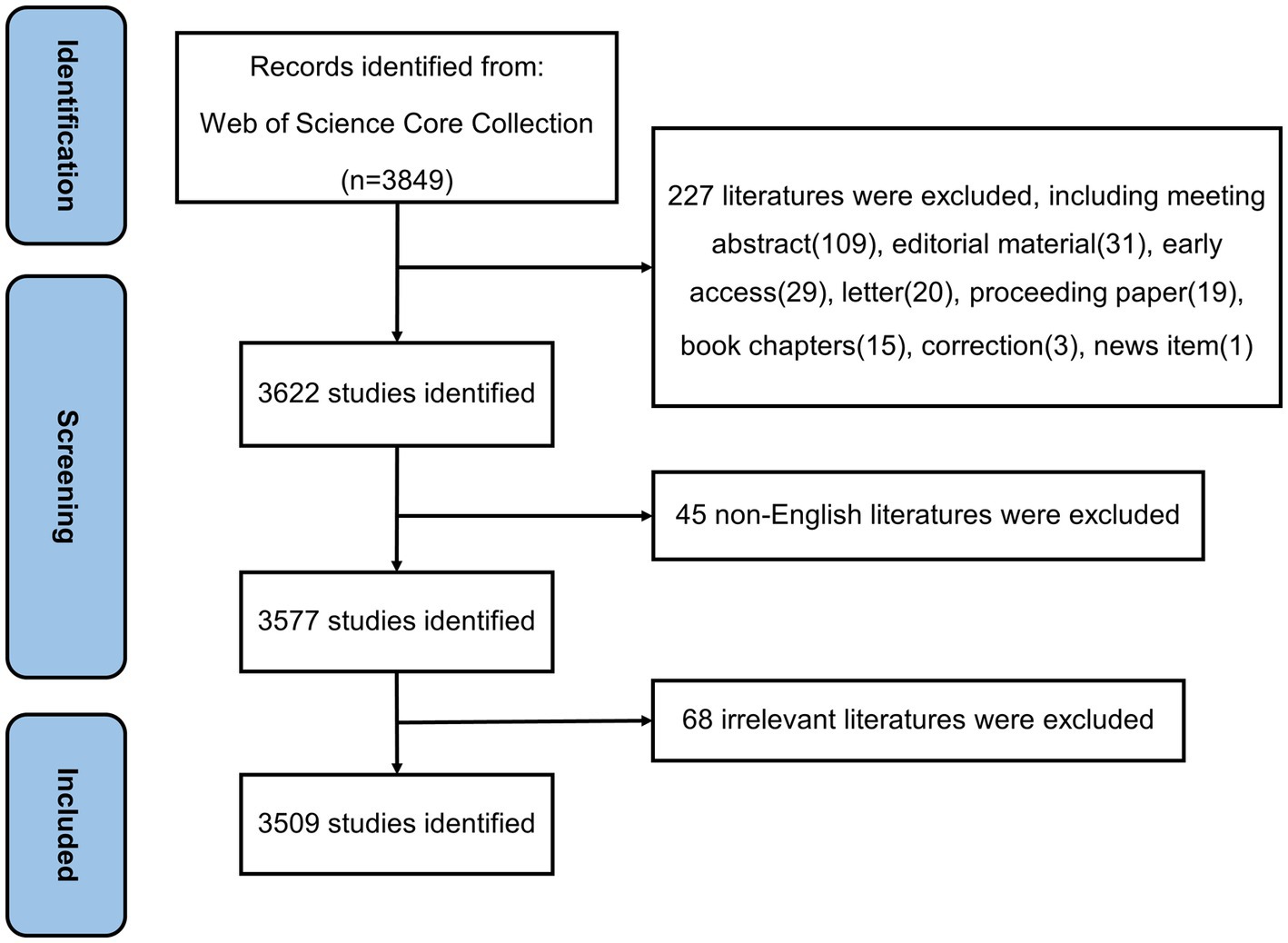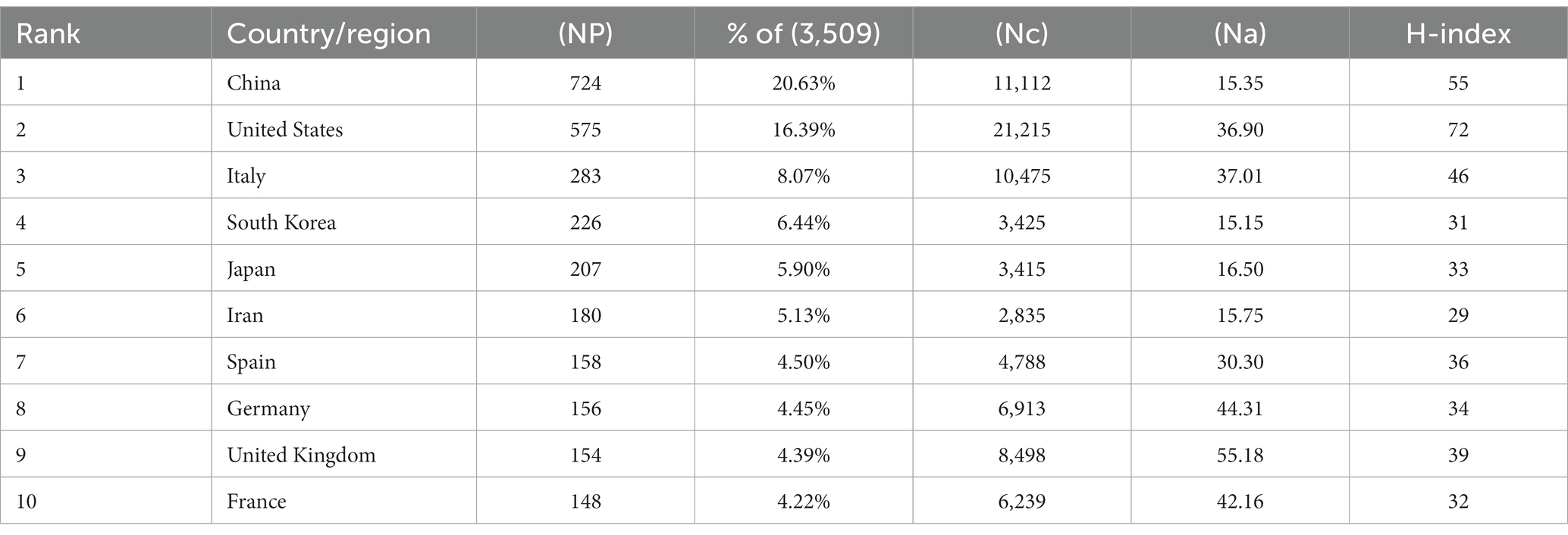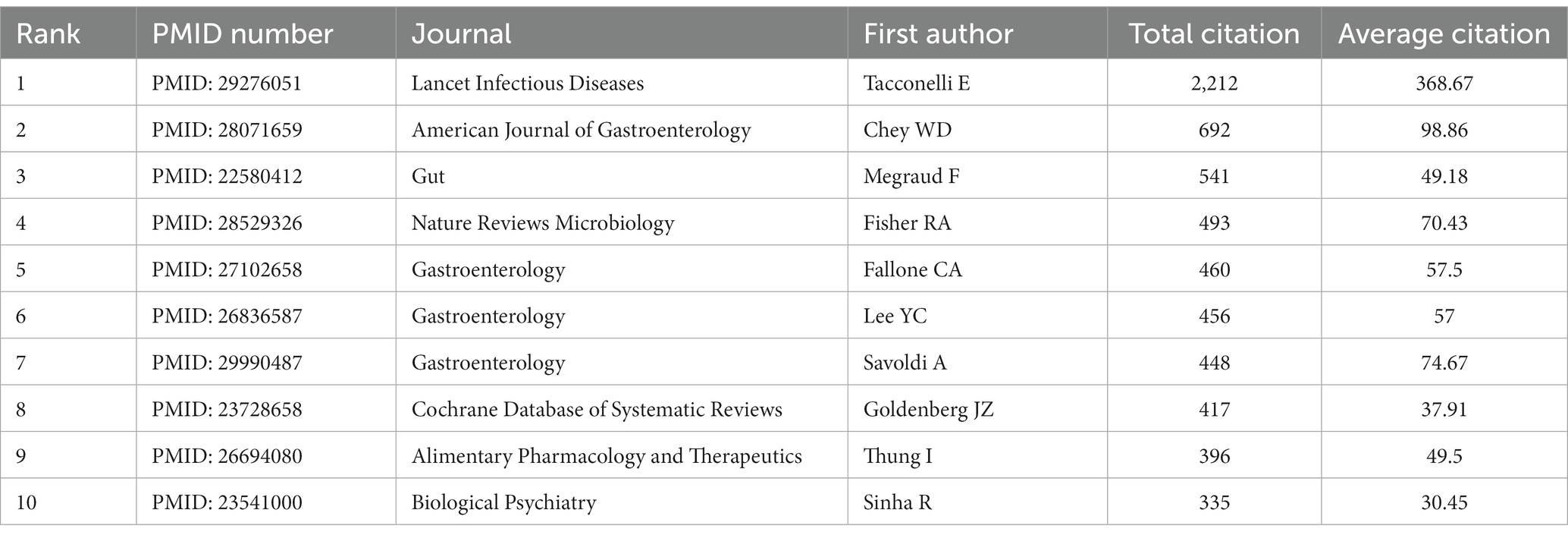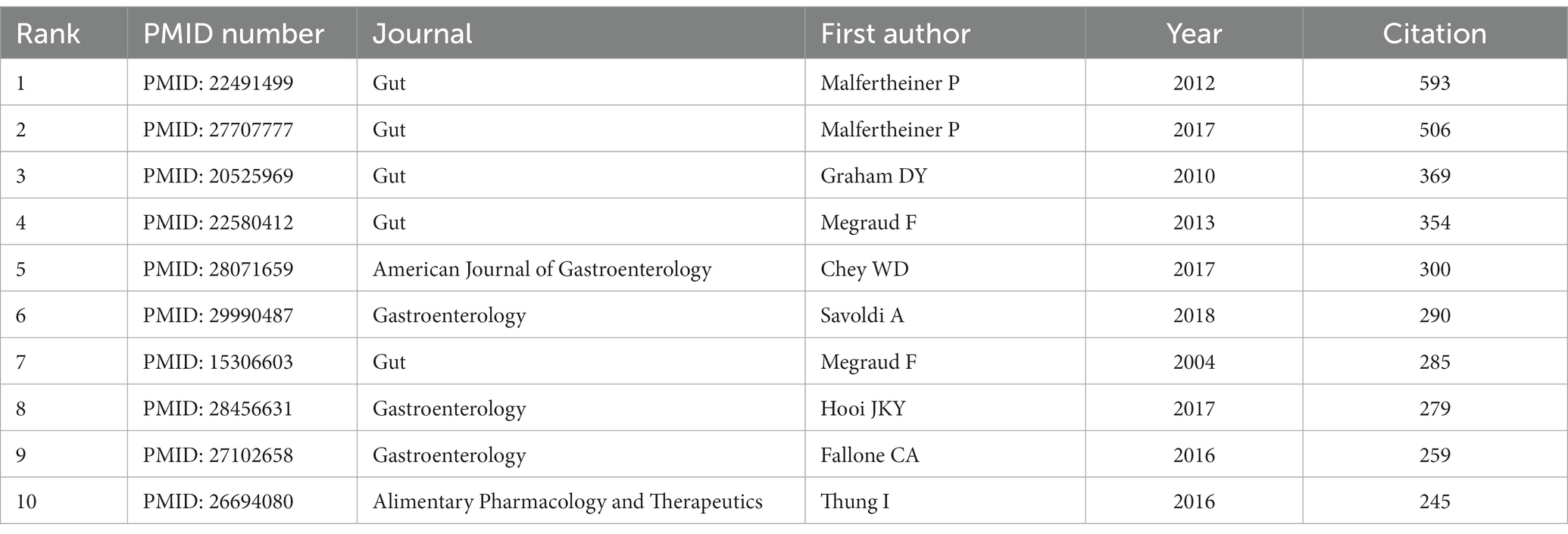- 1Hunan Provincial Key Laboratory of Traditional Chinese Medicine Diagnostics, Hunan University of Chinese Medicine, Changsha, Hunan, China
- 2School of Medicine, Hunan University of Chinese Medicine, Changsha, Hunan, China
- 3School of Traditional Chinese Medicine, Hunan University of Chinese Medicine, Changsha, Hunan, China
- 4The First Affiliated Hospital of Hunan University of Chinese Medicine, Changsha, Hunan, China
Resistance of Helicobacter pylori (H. pylori) to antibiotics has reached alarming levels worldwide, and the efficacy of the H. pylori eradication treatment has decreased dramatically because of antibiotic resistance. To gain a more comprehensive understanding of the development status, research hotspots, and future trends related to H. pylori antibiotic resistance, we conducted a thorough retrospective analysis via the bibliometrics method. We searched the Science Citation Index Expanded of the Web of Science Core Collection for all pertinent articles on H. pylori antibiotic resistance from 2013 to 2022. R-bibliometrix, CiteSpace, and VOSviewer tools were utilized to depict statistical evaluations in order to provide an unbiased presentation and forecasts in the field. We incorporated a total of 3,509 articles related to H. pylori antibiotic resistance. Publications were inconsistent prior to 2017, but steadily increased after 2017. China generated the most papers and the United States of America received the most citations and the highest H-index. Baylor College of Medicine was the most influential institution in this field, with the highest number of publications and citations, as well as the highest H-index. Helicobacter was the most productive journal, followed by the World Journal of Gastroenterology and Frontiers in Microbiology. The World Journal of Gastroenterology had the highest citation. Graham, David Y was the most productive and cited author. Clarithromycin resistance, prevalence, gastric cancer, quadruple therapy, sequential therapy, 23S rRNA, whole genome sequencing, bismuth, and probiotics appeared with a high frequency in the keywords. The top keywords with the highest citation bursts were vonoprazan, RdxA, biofilm formation, and fatty acid chain. Our research illustrated a multi-dimensional facet and a holistic knowledge structure for H. pylori antibiotic resistance research over the past decade, which can serve as a guide for the H. pylori research community to conduct in-depth investigations in the future.
1. Introduction
The gram-negative spiral bacterium Helicobacter pylori (H. pylori) colonizes over 50% of all humans because the immune system fails to eliminate it from the upper gastrointestinal tract regularly (Fukase et al., 2008). As the main cause of gastritis, gastric ulcer, duodenal ulcer, and gastric cancer, H. pylori infection causes worldwide concern (Sugano et al., 2015). The third most common cause of cancer death worldwide is gastric cancer, which is mainly caused by infection with H. pylori (Chiang et al., 2021).
Traditionally, H. pylori had been treated with a standard triple therapy (STT) consisting of proton pump inhibitors (PPIs), clarithromycins (CAMs), and amoxicillins (AMPCs) (Malfertheiner et al., 2022). However, H. pylori eradication rates have declined to unacceptable levels because of high resistance to metronidazole and clarithromycin with the widespread use STT regimen (Ho et al., 2022). According to certain research, eliminating H. pylori with STT did not even reach 50% (Dore et al., 2000; Luther et al., 2010; Venerito et al., 2013). Accordingly, in locations with high clarithromycin resistance levels (>15%), current international standards suggest bismuth quadruple therapy (PPI, tetracycline, bismuth, and metronidazole) or concomitant non-bismuth quadruple therapy (PPI, amoxicillin, clarithromycin, and metronidazole) for 14 days (Fallone et al., 2016; Chey et al., 2017; Malfertheiner et al., 2022). Due to the high antibiotic resistance, H. pylori is included in the WHO Global Priority List of Antibiotic-Resistant Bacteria (Tacconelli et al., 2018), underscoring the urgency of developing an eradication drug that targets and kills the bacteria. Alternatives (such as quadruple regimens, sequential regimens, concomitant regimens, and levofloxacin-containing triple regimens) differ greatly in effectiveness (Nyssen et al., 2016; Thung et al., 2016).
In recent years, as research on H. pylori progresses, there has been a significant increase in the volume of scholarly literature produced in this field. Faced with the vast body of publications, traditional analysis methods are no longer sufficient to accurately capture the evolving developments of this research area. Bibliometric analysis is an approach that statistically and quantitatively examines academic publications (Kokol et al., 2021). By utilizing literature retrieval system and metrology to analyze publications, researchers can gain a comprehensive understanding of publications from multiple perspectives. This enables them to evaluate the history, current state, and future potential of these publications, as well as their quantity and quality. As a result of bibliometric analysis, network knowledge maps can be drawn, new trends can be predicted, and recent advancements in a specific field can be displayed (Guler et al., 2016; Sainan et al., 2022). The current utilization of bibliometrics in the medical field can provide valuable insights into academic trends, pharmacotherapy, and disease progression, as well as the overall trends in healthcare (Thompson and Walker, 2015; Kokol et al., 2021). A number of bibliometric assessments have been published in the biological sector in the past few years, but there are few bibliometric analyses available on the antibiotic resistance in H. pylori. Consequently, this research employs two bibliometric applications, VOSviewer and CiteSpace, to measure the extent of research on H. pylori antibiotic resistance and recognize the most popular scientific questions in recent years. It is hoped that the results will provide clinicians and related researchers with useful information and further assist them in conducting more in-depth investigations.
2. Materials and methods
2.1. Search and inclusion criteria
The data were sourced from the Science Citation Index Expanded (SCI-E) within the Web of Science Core Collection (WoSCC). The search strategies were shown as follows: TS = (Helicobacter pylori or HP or H. pylori) AND TS = (drug resistance or drug tolerance or antibiotic resistance or antimicrobial resistance or antimicrobial agent or antibiotic). Here, TS referred to the subject matter as denoted by WoSCC. The time span of this research was: 2013–2022. To ensure data accuracy, the literature production search was completed on a single day (11 January 2023), and only articles and reviews written in English were considered. During the search, 3,509 publications were found. A detailed description of the screening process can be found in Figure 1. For further analysis, relevant articles were exported and stored in text file (including the entire record and cited references).
2.2. Data processing
We extracted the raw data from WoSCC, which primarily consisted of year of publication, author, country/region, institution, journal, H-index, references, and keywords. Initially, we eliminated duplicate authors and misspelled elements manually. Secondly, we merged names of the same country represented differently. Subsequently, we utilized a synonym database file to combine some duplicate words into a single word, corrected misspelled elements, and removed irrelevant words before analyzing the data using CiteSpace and VOSviewer.
2.3. Data analysis
2.3.1. Data analysis based on bioinformatics
As an online platform, bioinformatics1 was used to generate the following images: the world map of publication distribution, the heat map of top 10 countries in publication rankings, the pie chart of the top 10 research areas, and the bubble chart of the top 10 most cited papers. It is important to note that the bioinformatics platform integrates and utilizes the capabilities of R-bibliometrix, a comprehensive R package for bibliometric analysis.
2.3.2. Data analysis based on CiteSpace
Developed by Professor Chen, CiteSpace is a Java application for bibliometric analysis (Chen, 2004). In CiteSpace, the dual-map overlay, timeline view, and citation bursts of keywords and references are all used to examine knowledge fields and trends visually (Liu et al., 2021). The CiteSpace tool can be used to identify emerging topics based on references with strong citation burstness. We imported the retrieved literature into CiteSpace for deduplication, and then analyzed the processed results. In our study, the CiteSpace settings were as follows: time slicing was performed from 2013 to 2022, with 1-year intervals per slice. Text proceedings were set as default. The pathfinder and pruning sliced networks were used to prune unnecessary links. The “Overlay Map” button was used to generate the dual-map overlay, the “Layout” button to create the timeline view of keywords and references, and the “Burstness” button to display the citation bursts of keywords and references.
2.3.3. Data analysis based on VOSviewer
Developed by Leiden University’s Center for Science and Technology Research, VOSviewer is a network analysis software for scientific metrics. With VOSviewer, closely related nodes can be clustered by color, with the same color indicating greater correlations (van Eck and Waltman, 2010). Nodes’ sizes reflect the number of publications, and lines’ thicknesses reflect the strength of their relationships. We used VOSviewer to classify references and keywords with high co-occurrence frequencies into clusters and create a density visualization of keywords.
3. Results
3.1. Annual quantitative distribution of publications
A graph showing annual trends in publications related to antibiotic resistance in H. pylori is shown in Figure 2A. There are 3,509 publications on antibiotic resistance in H. pylori, of which 2,682 are regular articles and 827 are review articles. A fluctuating upward trend was observed in the number of publications (Np) concerning antibiotic resistance in H. pylori between 2013 and 2022. A peak in the number of yearly papers occurred in 2022, when the Np reached 449 compared to 257 in 2013. Figure 2B displays a polynomial-fitting curve that illustrates the annual trend in paper publishing. Despite some minor fluctuations over the last decade, there has been a general inclination toward an increase in the number of published articles, as indicated by a correlation coefficient of 0.92. In general, these data suggest that H. pylori antibiotic resistance research has been of major interest and progressed rapidly in recent years.

Figure 2. (A) The number of annual publications on Helicobacter pylori antibiotic resistance research between 2013 and 2022. The vertical axis indicates the quantity of publications while the horizontal axis corresponds with the publication year. (B) Curve-fitting analysis of the overall annual growth trend for publications.
3.2. Country and regional distribution
There were 123 countries/regions contributing to the publication of research on antibiotic resistance in H. pylori between 2013 and 2022. An overview of the geographic distribution of papers on antibiotic resistance in H. pylori among all countries and regions can be found in Figure 3. Table 1 shows the top 10 countries and regions based on Np. R-bibliometrix software was employed to analyze all data, resulting in the automatic merging of England, Wales, and Scotland data for the country analysis, which was eventually presented as the United Kingdom. As shown in Table 1, China had the highest number of published papers (724/20.63%), followed by the United States (575/16.39%) and Italy (283/8.07%). The top three countries by number of citations were the United States (21,215), China (11,112), and Italy (10,475). Additionally, the H-index rankings in descending order were the United States (72), China (55), and Italy (46). Although Np was relatively low in the United Kingdom, France, and Germany, the number of average citations (Na) was significantly higher in these countries. It may be related to the generally higher quality of papers produced in United Kingdom, France, and Germany. The annual paper publication of the top 10 countries/regions is illustrated in Figure 4.
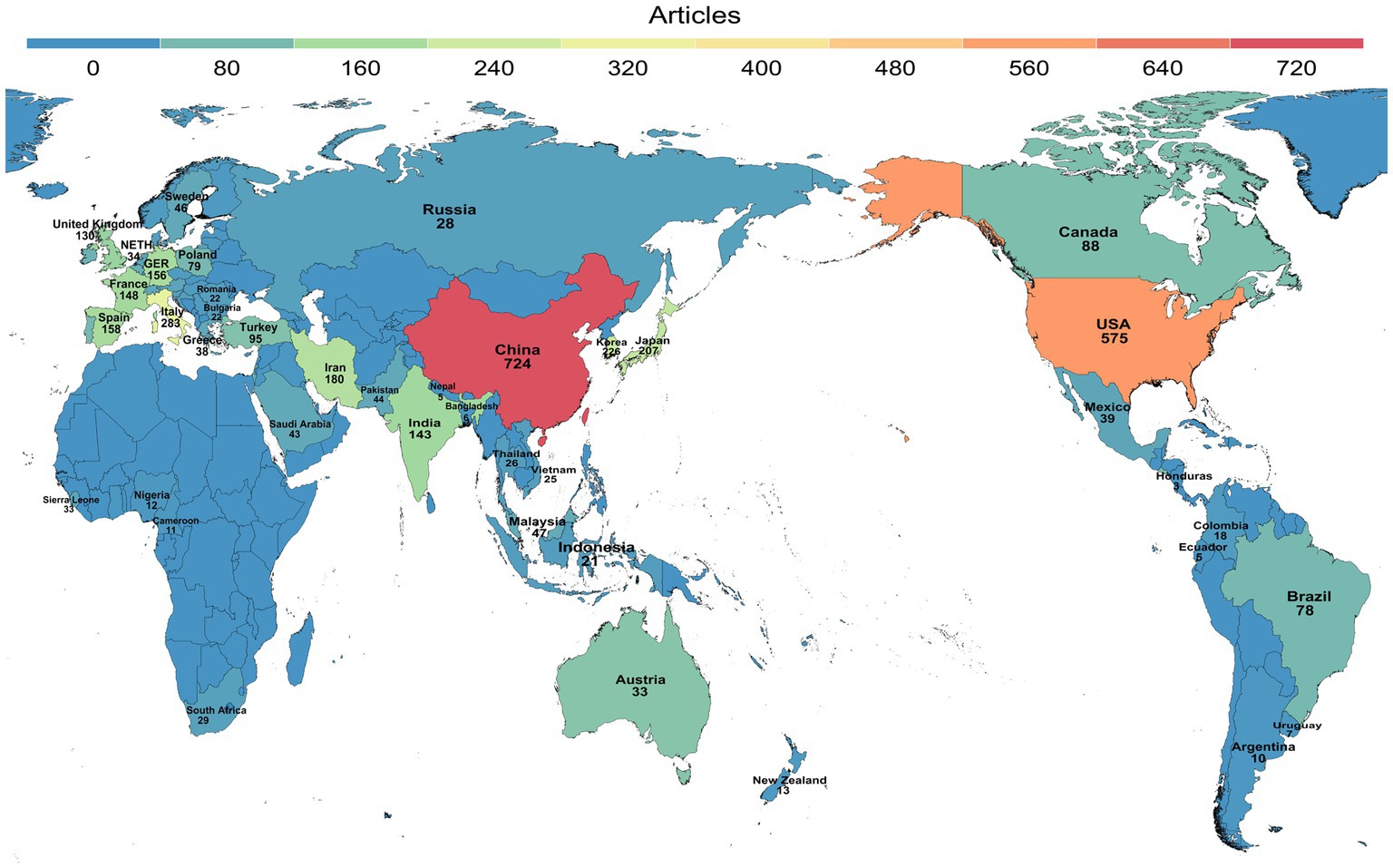
Figure 3. The contribution of every country based on publication counts is depicted on the world map.

Figure 4. Top 10 countries in terms of annual publications on Helicobacter pylori antibiotic resistance research, from 2013 to 2022. The square’s colors represent the number of papers. As the color changes from light green to dark blue, the number of articles issued increases.
3.3. Most productive institutions
A list of the top 10 institutions associated with the highest number of publications related to H. pylori’s antibiotic resistance was presented in Table 2. In terms of Np, Baylor College of Medicine ranked first (78). Shanghai Jiao Tong University was next (57), and Seoul National University was third (53). Baylor College of Medicine also had the highest Nc (3,653) and H-index (34) among all institutions. Baylor College of Medicine is a private medical school and is considered one of the most distinguished medical schools in America. The university has also made remarkable contributions to the domain of biomedicine.
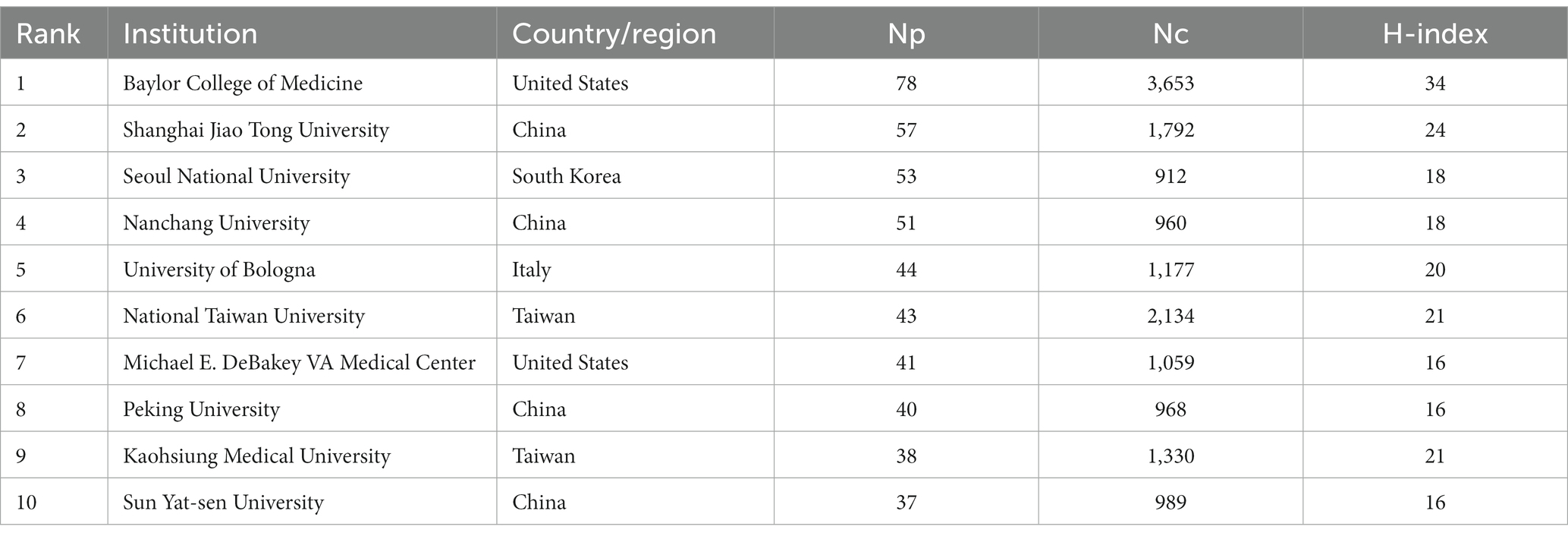
Table 2. Top 10 institutions with the highest number of publications in Helicobacter pylori antibiotic resistance research.
3.4. Most influential authors
A total of 16,873 authors have contributed to the development of antibiotic resistance associated with H. pylori. Table 3 presents the top 10 most productive authors and the most cited authors. Among the most productive team/labs, Graham, David Y’s team/lab published 44 articles, followed by Gisbert, Javier P (39 articles), and Megraud, Francis (31 articles). As to citations in this field, Graham, David Y topped the list with 2,807 local citations, followed by Wu, Ming-Shiang (1,579 local citations), and Gisbert, Javier P (1,544 local citations), while the rest of the authors had less than 1,500 local citations. Especially noteworthy, there is no doubt that Graham, David Y. is the most active researcher and has significantly contributed to the growth of the subject as evidenced by his largest number of publications and citations.
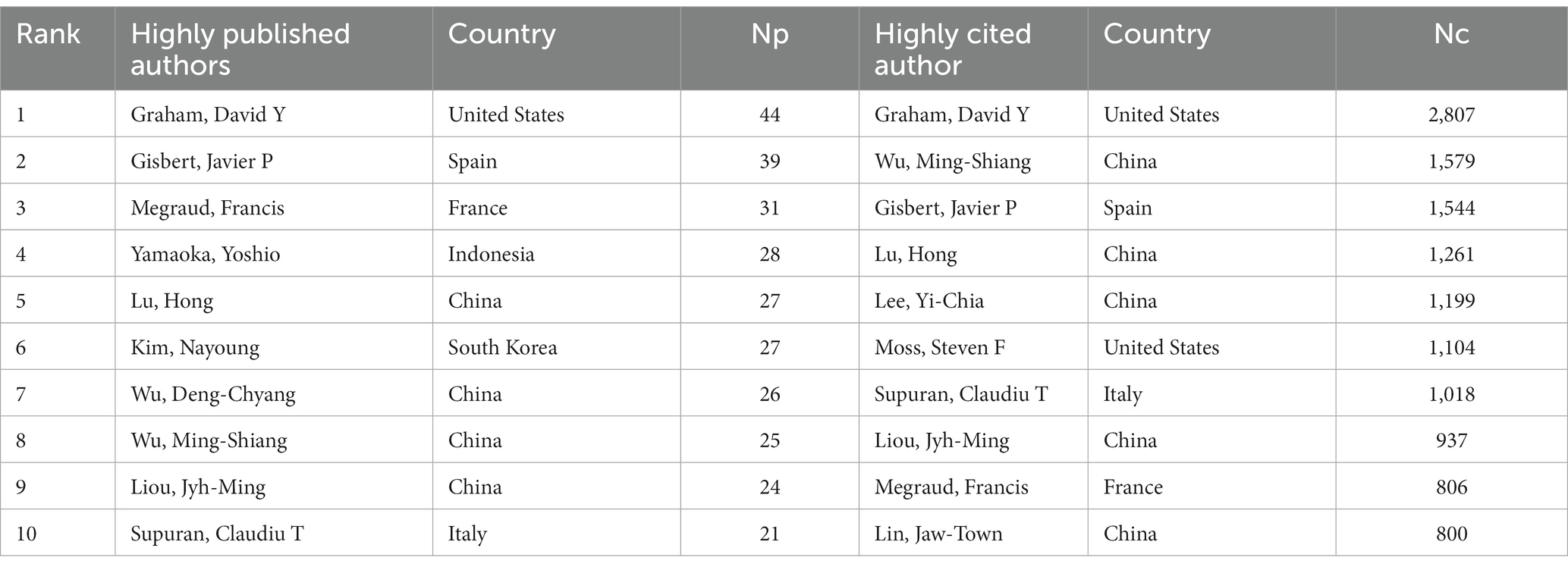
Table 3. Top 10 most productive and cited authors in Helicobacter pylori antibiotic resistance research.
3.5. Distribution of academic journals and disciplines
During the period 2003–2013, 3,509 articles were published in 1,038 journals. The top 10 journals with the most publications are included in Table 4 along with their most recent impact factors (IF). With 220 publications, Helicobacter accounted for 6.255% of all articles, followed by World Journal of Gastroenterology (127, 3.611%), and Frontiers in Microbiology (71, 2.019%). Among the top 10 journals, three belonged to the Q1 JCR division, while five had an IF exceeding five. A journal’s citations can be examined to identify its core journals, the top 10 most frequently cited journals are shown in Table 4. Among cited journals, World Journal of Gastroenterology was the most frequently cited (3,930), followed by Helicobacter (3,906), and Gastroenterology (1,983). In the Q1 Journal Citation Reports (JCR) for 2020, seven journals were at the division, and four out of the top 10 most cited journals had an IF exceeding 10.
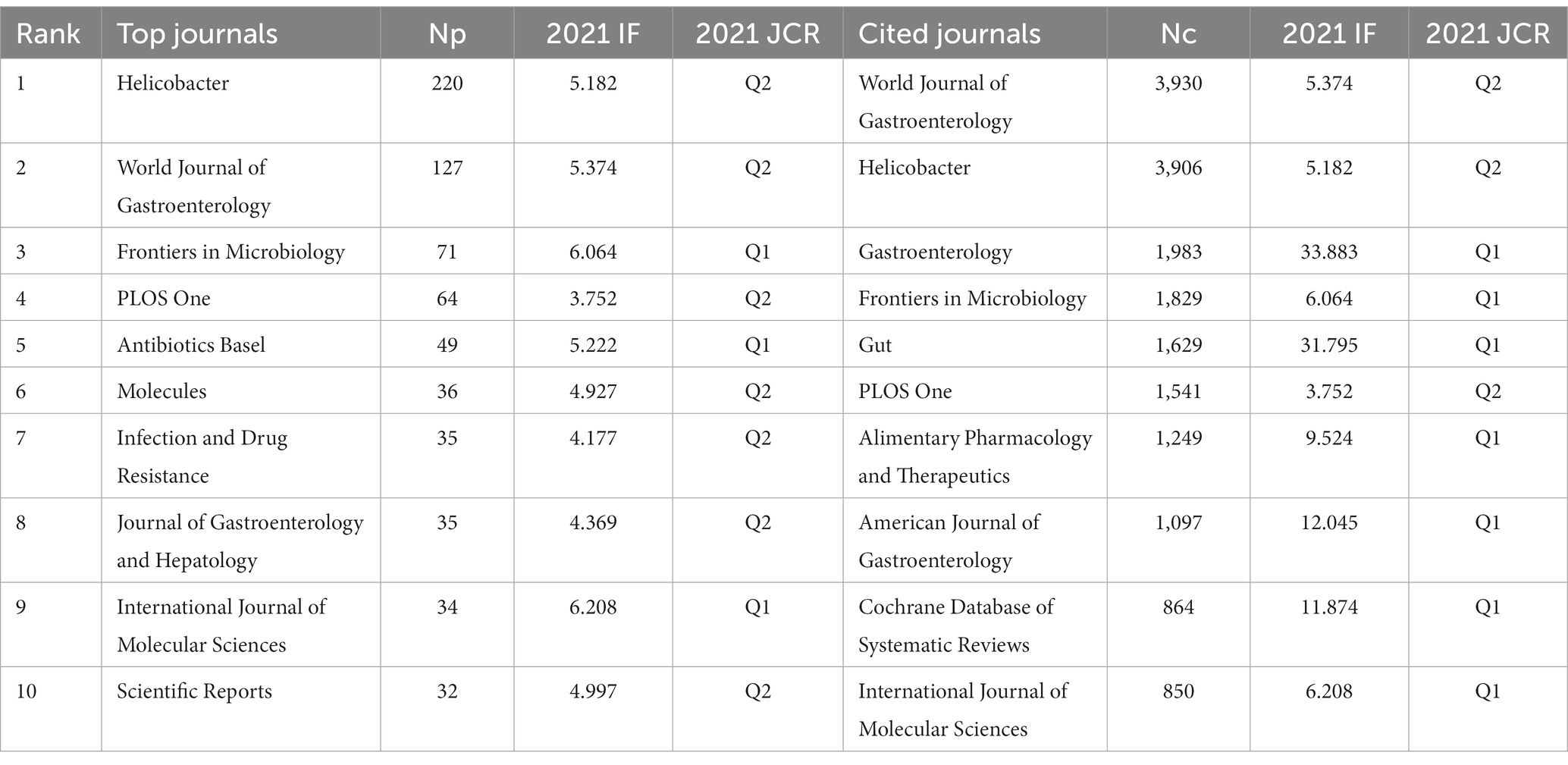
Table 4. The top 10 journals and cited journals of Helicobacter pylori antibiotic resistance research.
Chen and Leydesdorff developed a dual-map overlay analysis to reveal patterns within a scientific portfolio that match a global scientific literature map (Chen and Leydesdorff, 2014). As shown in Figure 5, a dual-map overlay depicts the publication of antibiotic resistance studies in H. pylori between 2013 and 2022. In this visual description, the retrieved records’ publication locations are represented by the left clusters, while the right clusters represent the locations where they were cited. The label is a representation of the topic addressed by the journal. The colored curves in the visualization correspond to lines of references, which originate from the citing map and extend toward the cited map. and this interaction illustrates the connections between different fields of research. The citation paths in our dataset were divided into four main categories. There were two main domains that covered most of the records: (1) medicine, medical, clinical, and (2) molecular, biology, immunology. Research content was primarily influenced by the following domains: (1) molecular, biology, genetics, and (2) health, nursing, and medicine. In total, the identified publications were categorized into 121 research areas. According to Figure 6, Microbiology was the most represented research area (848 records, 24.10% of all articles), followed by Gastroenterology Hepatology (837, 23.79% of all articles), and Pharmacology Pharmacy (562, 15.97% of all articles).
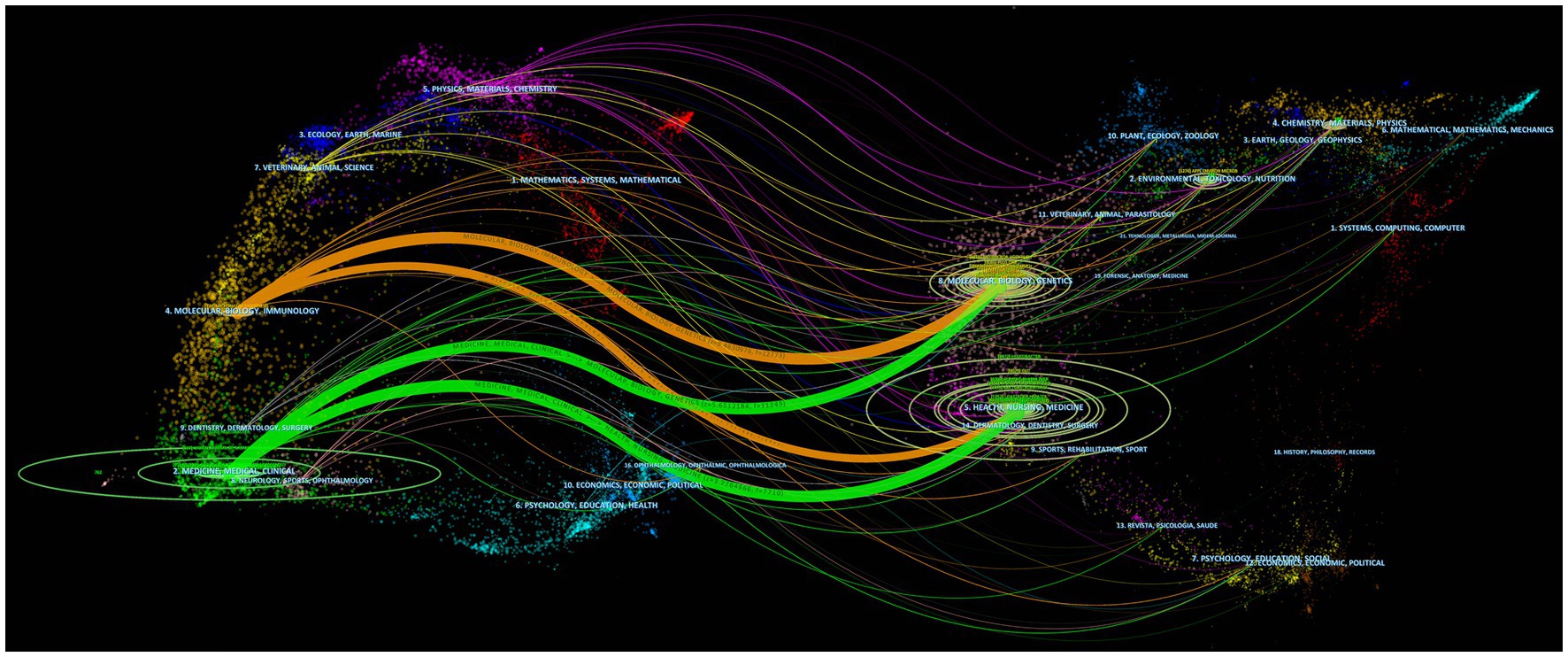
Figure 5. A biplot overlay of journals on Helicobacter pylori antibiotic resistance research. Every point depicted on the map corresponds to a journal, and the map is partitioned into two sections, featuring the citing map on the left side and the cited map on the right side. The curve is the citation line. The ellipse in the left panel denotes the quantity of publications associated with a journal and displays the proportion of authors to the number of publications; The length of the ellipse indicates the number of authors and the width of the ellipse indicates the number of publications.
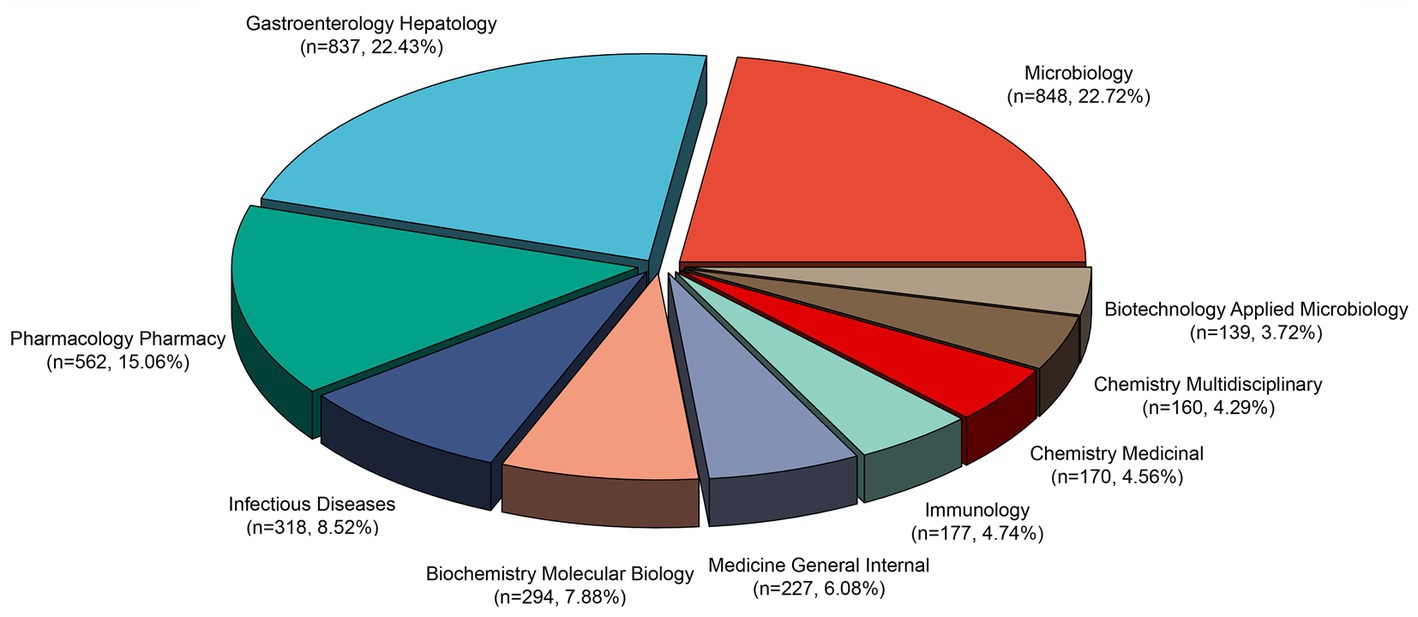
Figure 6. Top 10 research fields with the most published articles on antibiotic resistance in Helicobacter pylori.
3.6. Research hotspots and frontier analysis
3.6.1. Most cited articles
In bibliometric analysis, citation frequency is an important and representative indicator that measures academic influence and community display (Bruer, 1982; Nieminen et al., 2006; Poomkottayil et al., 2011). A ranking of the top 10 most cited articles is shown in Table 5. They were all published between 2013 and 2022, and all of them attracted more than 300 citations. With 2,212 citations, “Discovery, research, and development of new antibiotics: the WHO priority list of antibiotic-resistant bacteria and tuberculosis” published in 2018 is the most cited article in this field. In the article, antimicrobial-resistant bacteria are prioritized using multicriteria decision analysis to determine the most important antibiotic-resistant bacteria to eradicate. Figure 7 illustrates the annual count of worldwide citations for the top 10 most frequently cited papers.
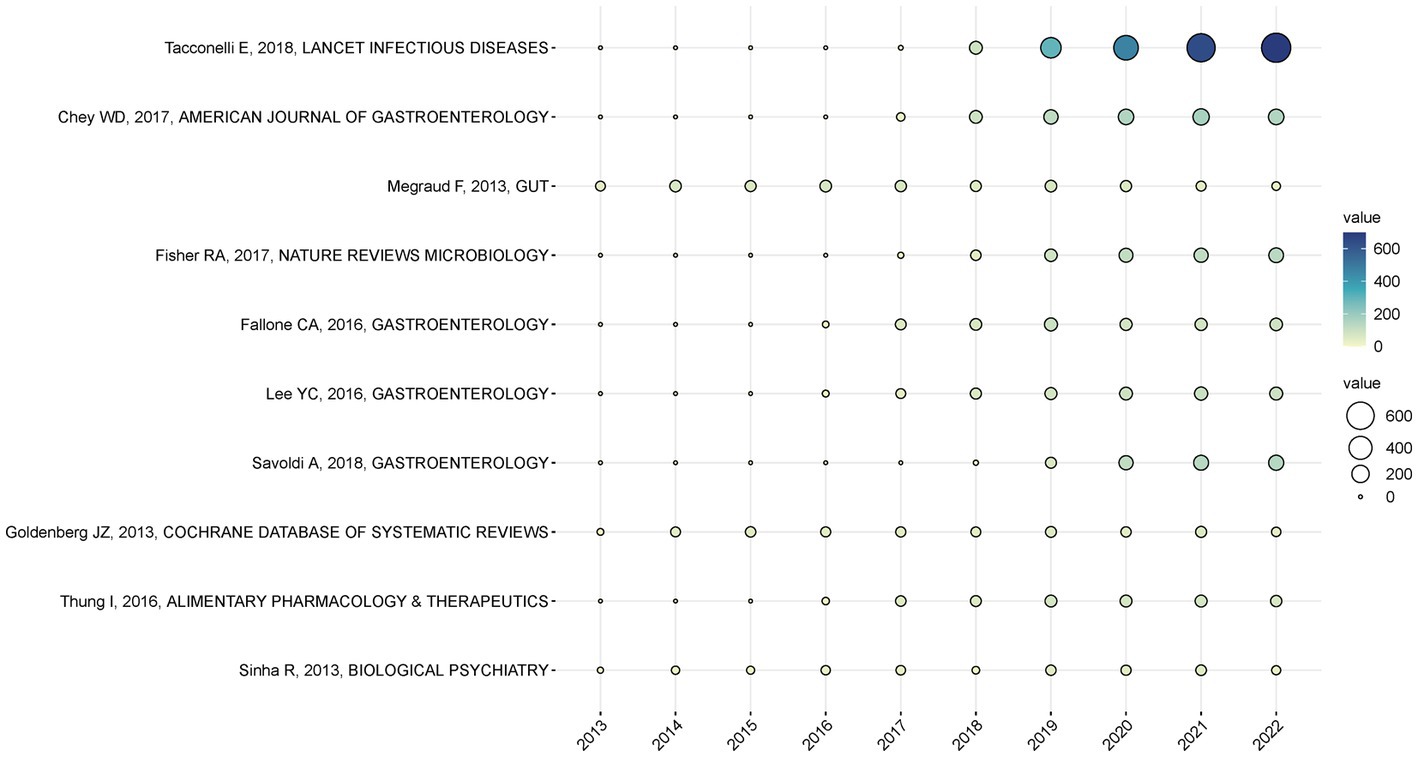
Figure 7. Annual citation of the top 10 most cited papers globally. Citations to the article are represented by circle’s size and color. Circles with a larger size and colors ranging from light green to dark blue indicate more times an article has been cited and its influence.
3.6.2. Co-cite reference analysis
“Co-cited references” are references that are cited by multiple publications simultaneously and can be used to represent the knowledge base of a particular area (Wang et al., 2022). Considering the massive amount of references cited, the incorporated document had to contain at least 30 citations. A total of 353 references were selected for co-citation analysis out of 12,4,113 publications mentioned in the retrieved documents. Table 6 lists the top 10 co-cited references. Malfertheiner P’s “Management of Helicobacter pylori infection-the Maastricht IV/ Florence Consensus Report”(593) and “Management of Helicobacter pylori infection-the Maastricht V/Florence Consensus Report”(506) published in GUT were the most co-cited references in relation to antibiotic resistance in H. pylori (Malfertheiner et al., 2012, 2017). Co-cited references are visualized as a network in Figure 8A. Nodes’ sizes indicate how often co-cited references occur, and the distance between nodes indicates how strong their association is. Co-cited references were subsequently grouped according to their indexing terms. A timeline view of distinct clusters can be seen in Figure 8B. The top 1 clusters of co-cited references consisted of concomitant, vonoprazan, 23 s rRNA, whole genome sequencing, probiotics, pylera, gut microbiota, biofilm, children, and mucosa-associated lymphold tissue lymphoma. In Figure 8C, we present the top 20 references with the highest citation bursts. Among the studies, Malfertheiner P’s study has the highest strength (126.26). Throughout his article, he outlines best practices for treating H. pylori infections in a variety of clinical scenarios based on the best available evidence. Furthermore, several articles are still experiencing citation bursts, such as “Prevalence of Antibiotic Resistance in Helicobacter pylori: A Systematic Review and Meta-analysis in World Health Organization Regions” suggesting that these topics are expected to remain popular for a while and may become a potential area of focus in research on antibiotic resistance in H. pylori.
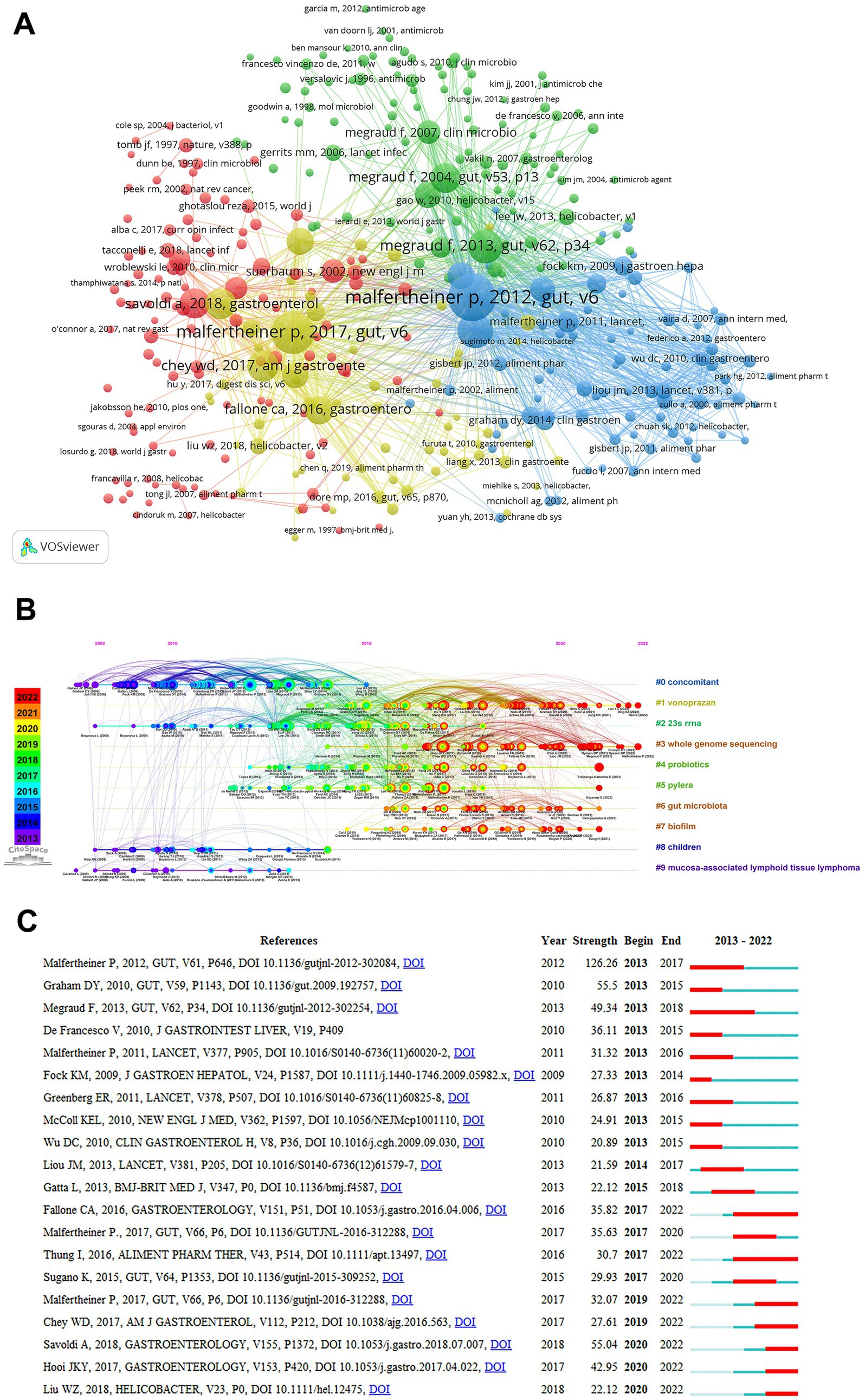
Figure 8. Mapping based on co-cited references from Helicobacter pylori antibiotic resistance research. (A) Network diagram of co-citation analysis of references cited more than 30 times. (B) The timeline view of co-cited references. (C) The top 20 references with the highest citation bursts. References were most influential between begin and end. The blue bar indicates that the reference has been published, while the red bar indicates that the citations have burst.
3.6.3. Keywords analysis
The keyword co-occurrence enables us to identify hot spots and directions in this field of research. With VOSviewer, we extracted 260 keywords (the minimum number of occurrences was 20) and merged words with similar meanings. Based on the results obtained in Figure 9A, four clusters with different colors are shown, corresponding to four different research directions and research scopes. Cluster 1 (red) contains 112 keywords, including gastric cancer, inflammation, mechanisms, identification, biofilm formation, crystal structure, Escherichia coli, and virulence factors. Cluster 2 (green) contains 63 keywords, including triple therapy, sequential therapy, eradication, clarithromycin, metronidazole, bismuth, proton pump inhibitor, meta-analysis, and levofloxacin. Cluster 3 (blue) contains 46 keywords, including antimicrobial susceptibility, PCR, point mutations, genotypes, prevalence, clarithromycin resistance, metronidazole resistance, 23S ribosomal RNA, 13C-urea breath test. Cluster 4 (yellow) contains 39 keywords, including probiotics, gut microbiota, dysbiosis, inflammatory bowel disease, antibiotic associated diarrhea, Saccharomyces boulardii, chain fatty acids, prevention, malt lymphoma. These keywords represent the hotspots for research related to H. pylori resistance. We employed a blend of qualitative and quantitative approaches, as shown in Supplementary Table 1, to analyze the clustering of keyword networks, which allowed us to pinpoint significant themes, hotspots, and emerging trends (Kokol et al., 2022). Keyword density maps (Figure 9B) can intuitively display these high-frequency keywords. Figure 9C shows the dynamic evolution of keywords clusters over time. In total, 6 clusters have been identified, including antibacterial, bismuth, gastric cancer, clarithromycin resistance, probiotics, and malt lymphoma. Figure 9D shows the top 20 keywords with the strongest bursts. In terms of keyword intensity, sequential therapy (strength = 11.53) was the top keyword, followed by randomized trial (7.25) and consensus report (7.23). It is noteworthy that the keywords vonoprazan, RdxA, biofilm formation, and chain fatty acid have been heavily cited recently, which indicates the future hotspots for research on H. pylori.
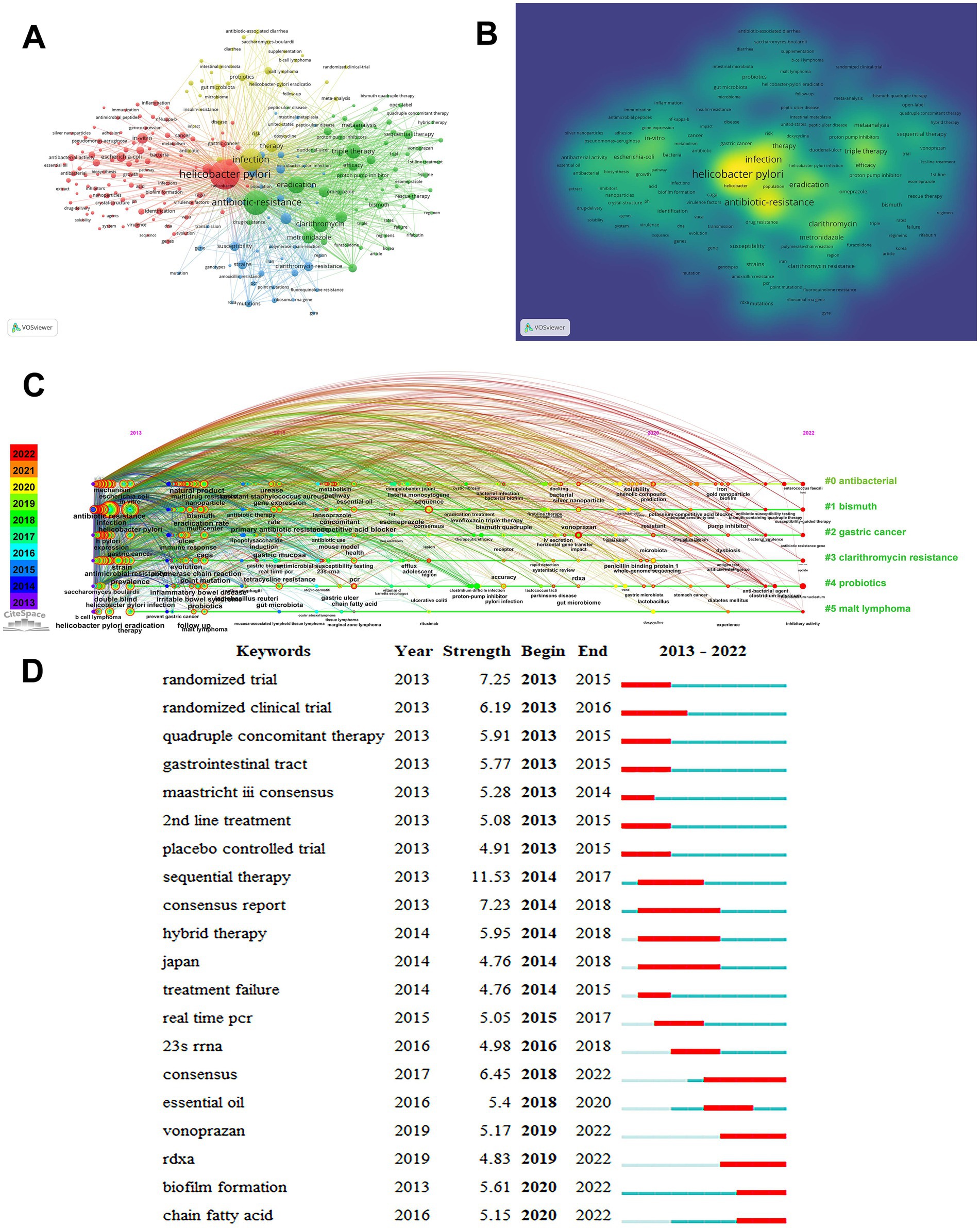
Figure 9. Mapping based on keywords from Helicobacter pylori antibiotic resistance research. (A) The co-occurrence network of frequently occurring keywords in H. pylori antibiotic resistance research. (B) Hot map of keywords research. More intense colors indicate higher keyword frequency. (C) The timeline view of keywords. (D) The top 20 most frequently cited keywords with the highest citation bursts.
4. Discussion
4.1. General information
The WHO designated eradication failure of H. pylori as an immediate priority in 2017. Similar to other efforts to improve H. pylori eradication rates, WHO’s agenda focuses primarily on H. pylori antibiotic resistance as the main cause of eradication failure (Savoldi et al., 2018; Tacconelli et al., 2018). Statistics on H. pylori antibiotic resistance papers published each year can help us understand the topic’s development trend. Publications on H. pylori antibiotic resistance have generally increased over the past few years. It can be divided into two stages, including a period of rising volatility (2013–2017), and a period of continuous growth (2017–2022). In the period following 2017, this field began to receive extensive attention, based on the increasing number of papers published each year. A possible explanation is that authoritative Consensus guidelines were issued. The publication of “Discovery, research, and development of new antibiotics: the WHO priority list of antibiotic-resistant bacteria and tuberculosis” aroused scientists’ enthusiasm for H. pylori antibiotic resistance, which greatly contributed to its development (Tacconelli et al., 2018). According to the polynomial fitting curve, despite a slight fluctuation in published papers in the last 10 years, it can be predicted that the number of published papers will continue to grow positively.
Based on national contributions, China published the most articles worldwide, indicating China has become a major player in H. pylori antibiotic resistance research. In addition, there were four Chinese institutions in the top 10 most productive institutions, including Shanghai Jiao Tong University, Nanchang University, Peking University, and Sun Yat-sen University, indicating that Chinese research institutions have become increasingly concerned with H. pylori antibiotic resistance. However, in comparison to China, the United States had relatively high Nc and Na, and it ranked first among all countries in terms of both Nc and H-index, indicating a greater influence of academia in this field. Notably, Germany, United Kingdom, and France all exhibit a high Na, suggesting that the caliber of academic works from these countries is widely acknowledged on a global scale. According to these findings, countries should prioritize promoting original innovation and creative discovery in academia, as the number of publications alone cannot fully capture academic influence. Chinese scholars and institutions should make more efforts to improve the quality of their research in the field of H. pylori antibiotic resistance. Further, we found that there is an imbalance in the global distribution of current research in this particular field, with papers of high quality and large scale concentrated in developed countries. This may be because governmental expenditure on healthcare is higher in these countries.
Based on the analysis of authors and cited authors, Graham, David Y from Baylor College of Medicine has the highest productivity and citation rates among all authors in the field of H. pylori antibiotic resistance, with 44 publications and 2,807 citations. During the period 2013 to 2022, Graham, David Y published every year except 2022. Graham, David Y’s team focused on the efficacy of different therapies for H. pylori eradication and the resistance rate of H. pylori to different antibiotics. In 2018, David Y Graham’s team conducted a comprehensive assessment of global antibiotic resistance patterns spanning a decade and found that clarithromycin, levofloxacin, and metronidazole resistance exceeded the threshold across most WHO regions (Savoldi et al., 2018). Moreover, Gisbert Javier P, Megraud Francis, Wu Ming-Shiang, and Lu Hong et al. also made great contributions to H. pylori antibiotic resistance research.
The assessment of scholarly journals can help authors in selecting the most fitting journals for their research outcomes. Generally, a journal’s impact and its articles’ impact are closely related (Callaham et al., 2002). IF is a metric that can gauge the influence of a journal by measuring its citation rate, academic rigor, and paper quality. Among the top 10 journals with the most papers published, five journals had an IF greater than five, and International Journal of Molecular Sciences had the highest IF (6.208). This indicates that the research conducted in this field holds significant scholarly worth and is widely acknowledged. The most productive journals for research on H. pylori antibiotic resistance were Helicobacter, World Journal of Gastroenterology, and Frontiers in Microbiology. In addition to producing high volumes, these journals maintain a high citation frequency, which contributes to the dissemination of research findings. Journals with high impact factors and high citation frequencies in this field include Gastroenterology, GUT, American Journal of Gastroenterology, and Cochrane Database of Systematic Review. In these journals, scholars can promote their ideas more easily. H. pylori antibiotic resistance involve multiple research areas including microbiology, Gastroenterology Hepatology, Pharmacology Pharmacy, Infectious Diseases, Biochemistry Molecular Biology, Medicine General Internal, Immunology, Chemistry Medicinal, Chemistry Multidisciplinary, Biotechnology Applied Microbiology, etc.
4.2. Knowledge base
A co-citation analysis can uncover the underlying trends of research literature categories over a specified duration, where studies with a high co-citation ranking are frequently deemed as the foundational research in a particular field (Yang et al., 2019). Below are the top 10 co-cited references related to H. pylori antibiotic resistance. Malfertheiner P published “Management of Helicobacter pylori infection-the Maastricht IV/Florence Consensus Report (Malfertheiner et al., 2012)” and “Management of Helicobacter pylori infection-the Maastricht V/Florence Consensus Report (Malfertheiner et al., 2017)” in GUT in 2012 and 2017, which were the most cited papers, with 593 and 506 co-citations. During this study, a group of specialized professionals in the field were assembled to evaluate and deliberate on all pertinent clinical data, with the aim of developing clinical guidelines for the management of H. pylori. This research provides a theoretical reference for the clinical management of H. pylori. The third co-cited paper, “Helicobacter pylori treatment in the era of increasing antibiotic resistance (Graham and Fischbach, 2010),” was published by Graham DY in GUT in 2010. This article pointed out that STT has been greatly reduced in effectiveness due to resistance to clarithromycin but it is still used as a first-line treatment. This article recommends that when there is a lack of effective treatment plans, clinicians can try a 14-day concomitant quadruple treatment regimen, a 10-day sequential treatment, or a 14-day bismuth-containing quadruple treatment regimen. The fourth co-cited paper, “Helicobacter pylori resistance to antibiotics in Europe and its relationship to antibiotic consumption (Megraud et al., 2013)” was published by Megraud F in GUT in 2013. In this study, the researchers evaluated the resistance rate of H. pylori in Europe. It was found that among the 2,204 patients incorporated, clarithromycin’s H. pylori resistance rate was 17.5%, levofloxacin’s was 14.1%, and metronidazole’s was 34.9%. In addition, it noted that quinolone use correlates with levofloxacin resistance and long-acting macrolides correlate with clarithromycin resistance. The fifth co-cited paper, “ACG clinical guideline: treatment of Helicobacter pylori infection (Chey et al., 2017),” was published by Chey WD in American Journal of Gastroenterology in 2017. This article is a consensus guide, which is different from expert consensus based on international data. This study focuses on collecting research results for North America. The suggestions provided by this guide will be more suitable for researchers in North America. The sixth co-cited paper, “Prevalence of antibiotic resistance in Helicobacter pylori: a systematic review and meta-analysis in World Health Organization regions (Savoldi et al., 2018),” was published by Savoldi A in Gastroenterology in 2018. Through systematic evaluation and meta-analysis, this article evaluates the distribution of antibiotic resistance among H. pylori in the global population. In this study, the researchers collected 178 studies, including 1,4265 isolates from 66 countries. Results showed that most regions had exceeded 15% of the primary and secondary resistance rates of metronidazole, clarithromycin, and levofloxacin. The seventh co-cited paper, “H pylori antibiotic resistance: prevalence, importance, and advances in testing (Mégraud, 2004),” was published by Megraud F in GUT in 2004. This is a review article that systematically reviews the resistance rate of H. pylori to different antibiotics, the results of the antibiotic drug sensitivity experiments, and the detection technology of the H. pylori resistance. The eighth co-cited paper, “Global prevalence of Helicobacter pylori infection: systematic review and meta-analysis (Hooi et al., 2017),” was published by Hooi JKY in Gastroenterology in 2017. Based on the analysis of 184 samples from 62 countries, this article evaluates the epidemic rate of pylori in the world. The results showed that H. pylori prevalence varied widely between regions. The ninth co-cited paper, “The Toronto consensus for the treatment of Helicobacter pylori infection in adults (Fallone et al., 2016),” was published by Fallone CA in Gastroenterology in 2016. In this consensus, a comprehensive review of the literature production on the management of H. pylori infection has been conducted, along with updated recommendations for eradication therapy. The tenth co-cited paper, “Review article: the global emergence of Helicobacter pylori antibiotic resistance (Thung et al., 2016),” was published by Thung I in Alimentary Pharmacology and Therapeutics in 2016. This article systematically summarizes the latest trend of H. pylori antibiotics and current treatment paradigms. Among the top 10 co-cited articles, research reviews provide an overview of the knowledge base in the field, summarize long-term basic research results on H. pylori antibiotic resistance, and provide theoretical guidance for researchers in the area of gastrointestinal diseases.
4.3. Hotspots and frontiers
We can attain a more profound comprehension of the literature production and the research patterns in a specific discipline of H. pylori infection. Among the more representative keywords are: triple therapy, clarithromycin resistance, prevalence, gastric cancer, in vitro, Escherichia coli, sequential therapy, quadruple therapy, double blind, mutation, gene, antibacterial activity, proton pump inhibitor, rescue therapy, and Staphylococcus aureus. As a result of these keywords, we can summarize the general situation of H. pylori antibiotic resistance-related fields, including: (1) clarithromycin tolerance strongly reduces the effectiveness of triple therapy (Torres et al., 2001; Álvarez et al., 2009); (2) Chronic gastritis caused by H. pylori is closely associated with gastric cancer risk (Parsonnet et al., 1991; Sipponen et al., 1992); (3) As an alternative to first-line empirical therapy, bismuth-containing quadruple therapy has been demonstrated to be effective and safe. In addition, sequential therapy or a non-bismuth quadruple therapy is recommended if bismuth-containing quadruple therapy is unavailable (Malfertheiner et al., 2012); (4) Among H. pylori with clarithromycin-resistant strains, mutations of the 23S rRNA gene were associated with failure of the eradication treatment (Chen et al., 2017; Matta et al., 2018); (5) Antimicrobial activity and efficacy are the focus of this field of research (De et al., 2009; Wylie et al., 2022); (6) Rescue therapy, which is the treatment after the failure of H. pylori eradication therapy (Gisbert, 2008); (7) Research in this area relies on the prevalence of H. pylori in different regions (Thung et al., 2016; Savoldi et al., 2018).
The synthesis of keyword clustering information enables us to precisely delineate the research focus and scope within this field (Kokol et al., 2022). Cluster 1 predominantly comprises keywords associated with H. pylori infection research, including pathogenic mechanisms, virulence factors, gastrointestinal disorders, cell experiments, molecular biology, inflammation, immune response, and alternative therapies with natural products. Future research in H. pylori infection could focus on identifying novel pathogenic mechanisms and virulence factors that contribute to the development of gastrointestinal disorders. Additionally, studies may explore the role of inflammation and immune responses in H. pylori infection, as well as the potential benefits of alternative therapies and natural products to mitigate symptoms and prevent disease progression. Cluster 2 primarily contains keywords linked to treatment approaches and therapeutic effectiveness, such as eradication therapies, antibiotics, drugs, study methods, and guideline reports. Future studies in treatment approaches and therapeutic effectiveness for H. pylori infection may involve the development of new eradication therapies and the optimization of existing ones. Scientific research could also focus on the identification of more effective antibiotics and drugs, as well as the establishment of standardized study methods and guidelines to improve clinical outcomes and patient care. Cluster 3 mainly consists of keywords connected to the antibiotic resistance in H. pylori, including resistance to various antibiotics, genes, mutations, and detection methods using molecular techniques. With the increasing prevalence of antibiotic resistance in H. pylori, future research may concentrate on understanding the underlying genetic mechanisms and mutations that contribute to this resistance. Additionally, the development of more sensitive and accurate detection methods using molecular techniques could help monitor and track the emergence of resistant strains, ultimately informing better treatment strategies. Cluster 4 is chiefly composed of keywords concerning various probiotics and gut microbiota related to H. pylori, as well as bowel disease, symptoms, prevention, and treatment. The role of probiotics and gut microbiota in H. pylori infection presents a promising area for future research. Studies may investigate the potential benefits of probiotics in preventing and treating H. pylori-related bowel diseases and symptoms. Furthermore, scientific research could focus on understanding the complex interactions between H. pylori and the gut microbiota, which may lead to new strategies for maintaining a healthy gut environment and preventing infection. Overall, these clusters represent a diverse range of potential research directions, reflecting the multifaceted nature of H. pylori antibiotic resistance and the ongoing need for innovative approaches to combat this global health challenge.
According to the chronological presentation of co-cited references and keywords, vonoprazan, 23S rRNA, whole genome sequencing, probiotics, gut microbiota, biofilm, mucosa-associated lymphoid tissue lymphoma, and bismuth have consistently remained as focal points of shared interest over time. Vonoprazan is a novel potassium-competitive acid blocker that suppresses the production of gastric acid by inhibiting H+, K+ ATPase enzyme in gastric parietal cells and has been used in Japan to eradicate H. pylori infection (Sugimoto and Yamaoka, 2018; Yang et al., 2018). According to Min Li et al., vonoprazan has demonstrated greater efficacy than conventional proton pump inhibitor-based therapy in eliminating clarithromycin-resistant H. pylori strains (Li et al., 2018). Following the sequencing of multiple H. pylori genomes, Schlesinger, N. et al. reported that DNA arrays were a promising method for investigating the genetic diversity of H. pylori strains (Salama et al., 2000). In a report by Ge Wang et al., the primary cause of H. pylori’s resistance to clarithromycin was attributed to point mutations in the variable area of the 23S rRNA gene. These mutations cause a structural alteration in the clarithromycin binding sites, leading to reduced sensitivity and binding (Wang and Taylor, 1998). In recent times, there have been indications that combining probiotics with standard treatment can enhancing the therapy of H. pylori by augmenting eradication rates and mitigating the side effects of current pharmacotherapy (Lü et al., 2016; McFarland et al., 2016; Feng et al., 2017; Wang et al., 2017). However, whether probiotic supplementation contributes to H. pylori eradication remains controversial. Yini Dang et al. found that probiotics with triple therapy plus 14 days of treatment did not result in a greater reduction of H. pylori infection than placebo (Dang et al., 2014; Lu et al., 2016). The biofilm is a surface-associated community of bacteria embedded in an extracellular polymeric matrix. The biofilm that H. pylori forms on gastric mucosa protects it from antimicrobials. Biofilm plays an important role in the failure of antibacterial therapy, so exploring the molecular mechanisms of H. pylori biofilm formation has become a research hotbed (Hathroubi et al., 2018, 2020). Gastric mucosa-associated lymphoid tissue lymphoma (MALT) is an indolent B-cell neoplasm strongly associated with H. pylori infection. In epidemiological studies, H. pylori was found in over 90% of patients with gastric MALT lymphoma. Studies have shown that H. pylori is capable of stimulating lymphoma cell growth through mechanisms mediated by T cells (Wotherspoon et al., 1991; Zucca et al., 1998). Several studies have shown that bismuth-containing quadruple therapy is a highly effective treatment for eradicating H. pylori, including resistant strains as well as susceptible strains (Laine et al., 2003; Malfertheiner et al., 2011; Dore et al., 2016). These studies have provided insight into future developments of H. pylori antibiotic resistance.
5. Conclusion
This research utilized bibliometrics and visualization technology to succinctly outline and evaluate the worldwide state of research, development trends, prominent research avenues, and emerging focal points concerning antibiotic resistance in H. pylori. Our bibliometric study shows that the quantity of articles on H. pylori antibiotic resistance has experienced fluctuations over the past decade, although a general trend of steady growth remains unmistakable, indicating that antibiotic resistance in H. pylori is an important or urgent research topic. We have identified the primary contributors, publications, and regions within the research domain. China published the largest number of documents, while the US had the greatest influence. H. pylori’s drug resistance mechanism is a current research focus. There has been considerable interest in H. pylori’s antibiotic resistance genes. The role of RdxA in metronidazole sensitivity and the mutation of 23S rRNA gene have become potential hotspots in H. pylori resistance research. Additionally, H. pylori biofilm formation and its potential role in pathogenesis have received considerable attention. In the eradication treatment of H. pylori, vonoprazan and chain fatty acids have also been considered hot topics.
The bibliometric study on H. pylori antibiotic resistance provides valuable insights for researchers in this field. For guideline makers, this research provides a comprehensive overview of the current state of knowledge, enabling them to make informed decisions when formulating evidence-based policies and recommendations. Novice researchers can benefit from the study by gaining a clear understanding of the research landscape, hot spots, and trends, which can guide their future investigations and help them identify potential areas of focus. Finally, for clinicians, our research offers a valuable resource to stay updated on the latest findings and advancements in the field, ultimately allowing them to provide better care for their patients suffering from H. pylori infections and antibiotic resistant strains.
6. Strengths and limitations
We used VOSviewer, CiteSpace, and R (version 4.2.2) simultaneously to perform a comprehensive bibliometric analysis of the research on H. pylori antibiotic resistance. Multiple statistical tools make our statistical results more objective and accurate. This research offered a more comprehensive understanding of changing research priorities and patterns than conventional reviews. Nevertheless, it is not without its limitations. First, this study only included the WOS core database; other databases, such as PubMed, Medline, and Google Scholar, were not considered. As a result, the included literature production may be incomplete. Second, our research was restricted to reviews and articles published only in the English language, which may have led to the exclusion of certain high-quality papers. Third, certain inconsistencies may exist. For instance, an author may be affiliated with different institutions at different points in time. Finally, the selected publications were released between 2013 and 2022, and some studies published in 2023 with a low Nc were not considered. Therefore, this research has some latency.
Data availability statement
The raw data supporting the conclusions of this article will be made available by the authors, without undue reservation.
Author contributions
HS and MZ proposed and designed the entire study and revised and edited the final version. CYuan extensively reviewed the relevant literature production, established the inclusion and exclusion criteria for the study, and drafted the manuscript. CYu and SZ screened the literature production while QS identified the controversial portion. MX extracted and compiled data from the documents analyzed in this study. CYuan and CYu used softwares to visualize the data. All authors contributed to the article and approved the submitted version.
Funding
This study was funded by grants from the National Natural Science Foundation of China (nos. 81703920 and 82004427), China Postdoctoral Science Foundation (no. 2019M662790), Science and Technology Innovation Program of Hunan Province (no. 2021RC3101), Guidance Project of Academician Liu Liang’s Expert Workstation (no. 22YS003), Key Project of Science Research of Hunan Provincial Education Department (no. 21A0240), and Open-competing Disciple Construction Project of Hunan University of Chinese Medicine (no. 22JBZ027).
Conflict of interest
The authors declare that the research was conducted in the absence of any commercial or financial relationships that could be construed as a potential conflict of interest.
Publisher’s note
All claims expressed in this article are solely those of the authors and do not necessarily represent those of their affiliated organizations, or those of the publisher, the editors and the reviewers. Any product that may be evaluated in this article, or claim that may be made by its manufacturer, is not guaranteed or endorsed by the publisher.
Supplementary material
The Supplementary material for this article can be found online at: https://www.frontiersin.org/articles/10.3389/fmicb.2023.1208157/full#supplementary-material
Abbreviations
AMPCs, Proton pump inhibitor clarithromycin and amoxicillin; CAMs, Clarithromycins; H. pylori, Helicobacter pylori; IF, The impact factor; JCR, The journal citation report; Nc, The number of citations; Np, The number of publications; Na, The number of average citations; PPI, Proton pump inhibitors; SCI-expanded, Science citation index expanded; STT, Standard triple therapy; WoSCC, Web of science core collection.
Footnotes
References
Álvarez, A., Moncayo, J. I., Santacruz, J. J., Santacoloma, M., Corredor, L. F., and Reinosa, E. (2009). Antimicrobial susceptibility and mutations involved in clarithromycin resistance in Helicobacter pylori isolates from patients in the Western central region of Colombia. Antimicrob. Agents Chemother. 53, 4022–4024. doi: 10.1128/AAC.00145-09
Bruer, J. T. (1982). Methodological rigor and citation frequency in patient compliance literature. Am. J. Public Health 72, 1119–1123. doi: 10.2105/ajph.72.10.1119
Callaham, M., Wears, R. L., and Weber, E. (2002). Journal prestige, publication bias, and other characteristics associated with citation of published studies in peer-reviewed journals. JAMA 287, 2847–2850. doi: 10.1001/jama.287.21.2847
Chen, C. (2004). Searching for intellectual turning points: progressive knowledge domain visualization. Proc. Natl. Acad. Sci. U. S. A. 101, 5303–5310. doi: 10.1073/pnas.0307513100
Chen, D., Cunningham, S. A., Cole, N. C., Kohner, P. C., Mandrekar, J. N., and Patel, R. (2017). Phenotypic and molecular antimicrobial susceptibility of Helicobacter pylori. Antimicrob. Agents Chemother. 61, e02530–e02516. doi: 10.1128/AAC.02530-16
Chen, C., and Leydesdorff, L. (2014). Patterns of connections and movements in dual-map overlays: a new method of publication portfolio analysis. J. Assn. Inf. Sci. Tec. 65, 334–351. doi: 10.1002/asi.22968
Chey, W. D., Leontiadis, G. I., Howden, C. W., and Moss, S. F. (2017). ACG clinical guideline: treatment of Helicobacter pylori infection. Am. J. Gastroenterol. 112, 212–239. doi: 10.1038/ajg.2016.563
Chiang, T.-H., Chang, W.-J., Chen, S. L.-S., Yen, A. M.-F., Fann, J. C.-Y., Chiu, S. Y.-H., et al. (2021). Mass eradication of Helicobacter pylori to reduce gastric cancer incidence and mortality: a long-term cohort study on Matsu Islands. Gut 70, 243–250. doi: 10.1136/gutjnl-2020-322200
Dang, Y., Reinhardt, J. D., Zhou, X., and Zhang, G. (2014). The effect of probiotics supplementation on Helicobacter pylori eradication rates and side effects during eradication therapy: a meta-analysis. PLoS One 9:e111030. doi: 10.1371/journal.pone.0111030
De, R., Kundu, P., Swarnakar, S., Ramamurthy, T., Chowdhury, A., Nair, G. B., et al. (2009). Antimicrobial activity of Curcumin against Helicobacter pylori isolates from India and during infections in mice. Antimicrob. Agents Chemother. 53, 1592–1597. doi: 10.1128/AAC.01242-08
Dore, M. P., Leandro, G., Realdi, G., Sepulveda, A. R., and Graham, D. Y. (2000). Effect of pretreatment antibiotic resistance to metronidazole and clarithromycin on outcome of Helicobacter pylori therapy: a meta-analytical approach. Dig. Dis. Sci. 45, 68–76. doi: 10.1023/a:1005457226341
Dore, M. P., Lu, H., and Graham, D. Y. (2016). Role of bismuth in improving Helicobacter pylori eradication with triple therapy. Gut 65, 870–878. doi: 10.1136/gutjnl-2015-311019
Fallone, C. A., Chiba, N., Zanten, S. V., Fischbach, L., Gisbert, J. P., Hunt, R. H., et al. (2016). The Toronto consensus for the treatment of Helicobacter pylori infection in adults. Gastroenterology 151, 51–69.e14. doi: 10.1053/j.gastro.2016.04.006
Feng, J.-R., Wang, F., Qiu, X., McFarland, L. V., Chen, P.-F., Zhou, R., et al. (2017). Efficacy and safety of probiotic-supplemented triple therapy for eradication of Helicobacter pylori in children: a systematic review and network meta-analysis. Eur. J. Clin. Pharmacol. 73, 1199–1208. doi: 10.1007/s00228-017-2291-6
Fukase, K., Kato, M., Kikuchi, S., Inoue, K., Uemura, N., Okamoto, S., et al. (2008). Effect of eradication of Helicobacter pylori on incidence of metachronous gastric carcinoma after endoscopic resection of early gastric cancer: an open-label, randomised controlled trial. Lancet 372, 392–397. doi: 10.1016/S0140-6736(08)61159-9
Gisbert, J. P. (2008). “Rescue” regimens after Helicobacter pylori treatment failure. World J. Gastroenterol. 14, 5385–5402. doi: 10.3748/wjg.14.5385
Graham, D. Y., and Fischbach, L. (2010). Helicobacter pylori treatment in the era of increasing antibiotic resistance. Gut 59, 1143–1153. doi: 10.1136/gut.2009.192757
Guler, A. T., Waaijer, C. J. F., and Palmblad, M. (2016). Scientific workflows for bibliometrics. Scientometrics 107, 385–398. doi: 10.1007/s11192-016-1885-6
Hathroubi, S., Servetas, S. L., Windham, I., Merrell, D. S., and Ottemann, K. M. (2018). Helicobacter pylori biofilm formation and its potential role in pathogenesis. Microbiol. Mol. Biol. Rev. 82, e00001–e00018. doi: 10.1128/MMBR.00001-18
Hathroubi, S., Zerebinski, J., Clarke, A., and Ottemann, K. M. (2020). Helicobacter pylori biofilm confers antibiotic tolerance in part via a protein-dependent mechanism. Antibiotics 9:355. doi: 10.3390/antibiotics9060355
Ho, J. J. C., Navarro, M., Sawyer, K., Elfanagely, Y., and Moss, S. F. (2022). Helicobacter pylori antibiotic resistance in the United States between 2011 and 2021: a systematic review and Meta-analysis. Am. J. Gastroenterol. 117, 1221–1230. doi: 10.14309/ajg.0000000000001828
Hooi, J. K. Y., Lai, W. Y., Ng, W. K., Suen, M. M. Y., Underwood, F. E., Tanyingoh, D., et al. (2017). Global prevalence of Helicobacter pylori infection: systematic review and Meta-analysis. Gastroenterology 153, 420–429. doi: 10.1053/j.gastro.2017.04.022
Kokol, P., Blažun Vošner, H., and Završnik, J. (2021). Application of bibliometrics in medicine: a historical bibliometrics analysis. Health Info. Libr. J. 38, 125–138. doi: 10.1111/hir.12295
Kokol, P., Kokol, M., and Zagoranski, S. (2022). Machine learning on small size samples: a synthetic knowledge synthesis. Sci. Prog. 105:003685042110297. doi: 10.1177/00368504211029777
Laine, L., Hunt, R., El-Zimaity, H., Nguyen, B., Osato, M., and Spénard, J. (2003). Bismuth-based quadruple therapy using a single capsule of bismuth biskalcitrate, metronidazole, and tetracycline given with omeprazole versus omeprazole, amoxicillin, and clarithromycin for eradication of Helicobacter pylori in duodenal ulcer patients: a prospective, randomized, multicenter, north American trial. Am. J. Gastroenterol. 98, 562–567. doi: 10.1111/j.1572-0241.2003.t01-1-07288.x
Li, M., Oshima, T., Horikawa, T., Tozawa, K., Tomita, T., Fukui, H., et al. (2018). Systematic review with meta-analysis: Vonoprazan, a potent acid blocker, is superior to proton-pump inhibitors for eradication of clarithromycin-resistant strains of Helicobacter pylori. Helicobacter 23:e12495. doi: 10.1111/hel.12495
Liu, T., Yang, L., Mao, H., Ma, F., Wang, Y., and Zhan, Y. (2021). Knowledge domain and emerging trends in Podocyte injury research from 1994 to 2021: a Bibliometric and visualized analysis. Front. Pharmacol. 12:772386. doi: 10.3389/fphar.2021.772386
Lu, C., Sang, J., He, H., Wan, X., Lin, Y., Li, L., et al. (2016). Probiotic supplementation does not improve eradication rate of Helicobacter pylori infection compared to placebo based on standard therapy: a meta-analysis. Sci. Rep. 6:23522. doi: 10.1038/srep23522
Lü, M., Yu, S., Deng, J., Yan, Q., Yang, C., Xia, G., et al. (2016). Efficacy of probiotic supplementation therapy for Helicobacter pylori eradication: a Meta-analysis of randomized controlled trials. PLoS One 11:e0163743. doi: 10.1371/journal.pone.0163743
Luther, J., Higgins, P. D. R., Schoenfeld, P. S., Moayyedi, P., Vakil, N., and Chey, W. D. (2010). Empiric quadruple vs. triple therapy for primary treatment of Helicobacter pylori infection: systematic review and meta-analysis of efficacy and tolerability. Am. J. Gastroenterol. 105, 65–73. doi: 10.1038/ajg.2009.508
Malfertheiner, P., Bazzoli, F., Delchier, J.-C., Celiñski, K., Giguère, M., Rivière, M., et al. (2011). Helicobacter pylori eradication with a capsule containing bismuth subcitrate potassium, metronidazole, and tetracycline given with omeprazole versus clarithromycin-based triple therapy: a randomised, open-label, non-inferiority, phase 3 trial. Lancet 377, 905–913. doi: 10.1016/S0140-6736(11)60020-2
Malfertheiner, P., Megraud, F., O’Morain, C. A., Atherton, J., Axon, A. T. R., Bazzoli, F., et al. (2012). Management of Helicobacter pylori infection-the Maastricht IV/ Florence consensus report. Gut 61, 646–664. doi: 10.1136/gutjnl-2012-302084
Malfertheiner, P., Megraud, F., O’Morain, C. A., Gisbert, J. P., Kuipers, E. J., Axon, A. T., et al. (2017). Management of Helicobacter pylori infection-the Maastricht V/Florence consensus report. Gut 66, 6–30. doi: 10.1136/gutjnl-2016-312288
Malfertheiner, P., Megraud, F., Rokkas, T., Gisbert, J. P., Liou, J.-M., Schulz, C., et al. (2022). Management of Helicobacter pylori infection: the Maastricht VI/Florence consensus report. Gut 2022:327745. doi: 10.1136/gutjnl-2022-327745
Matta, A. J., Zambrano, D. C., and Pazos, A. J. (2018). Punctual mutations in 23S rRNA gene of clarithromycin-resistant Helicobacter pylori in Colombian populations. World J. Gastroenterol. 24, 1531–1539. doi: 10.3748/wjg.v24.i14.1531
McFarland, L. V., Huang, Y., Wang, L., and Malfertheiner, P. (2016). Systematic review and meta-analysis: multi-strain probiotics as adjunct therapy for Helicobacter pylori eradication and prevention of adverse events. United European Gastroenterol J 4, 546–561. doi: 10.1177/2050640615617358
Mégraud, F. (2004). H pylori antibiotic resistance: prevalence, importance, and advances in testing. Gut 53, 1374–1384. doi: 10.1136/gut.2003.022111
Megraud, F., Coenen, S., Versporten, A., Kist, M., Lopez-Brea, M., Hirschl, A. M., et al. (2013). Helicobacter pylori resistance to antibiotics in Europe and its relationship to antibiotic consumption. Gut 62, 34–42. doi: 10.1136/gutjnl-2012-302254
Nieminen, P., Carpenter, J., Rucker, G., and Schumacher, M. (2006). The relationship between quality of research and citation frequency. BMC Med. Res. Methodol. 6:42. doi: 10.1186/1471-2288-6-42
Nyssen, O. P., McNicholl, A. G., Megraud, F., Savarino, V., Oderda, G., Fallone, C. A., et al. (2016). Sequential versus standard triple first-line therapy for Helicobacter pylori eradication. Cochrane Database Syst. Rev. 2016:CD009034. doi: 10.1002/14651858.CD009034.pub2
Parsonnet, J., Friedman, G. D., Vandersteen, D. P., Chang, Y., Vogelman, J. H., Orentreich, N., et al. (1991). Helicobacter pylori infection and the risk of gastric carcinoma. N. Engl. J. Med. 325, 1127–1131. doi: 10.1056/NEJM199110173251603
Poomkottayil, D., Bornstein, M. M., and Sendi, P. (2011). Lost in translation: the impact of publication language on citation frequency in the scientific dental literature. Swiss Med. Wkly. 141:w13148. doi: 10.4414/smw.2011.13148
Sainan, T., Qinghua, P., Yinan, C., Congying, L., and Junfeng, Y. (2022). Visualization analysis of the research status of FU Qingzhu’s obstetrics and gynecology based on bibliometrics. Digit Chin Med 5, 93–102. doi: 10.1016/j.dcmed.2022.03.010
Salama, N., Guillemin, K., McDaniel, T. K., Sherlock, G., Tompkins, L., and Falkow, S. (2000). A whole-genome microarray reveals genetic diversity among Helicobacter pylori strains. Proc. Natl. Acad. Sci. U. S. A. 97, 14668–14673. doi: 10.1073/pnas.97.26.14668
Savoldi, A., Carrara, E., Graham, D. Y., Conti, M., and Tacconelli, E. (2018). Prevalence of antibiotic resistance in Helicobacter pylori: a systematic review and Meta-analysis in World Health Organization regions. Gastroenterology 155, 1372–1382.e17. doi: 10.1053/j.gastro.2018.07.007
Sipponen, P., Kosunen, T. U., Valle, J., Riihelä, M., and Seppälä, K. (1992). Helicobacter pylori infection and chronic gastritis in gastric cancer. J. Clin. Pathol. 45, 319–323. doi: 10.1136/jcp.45.4.319
Sugano, K., Tack, J., Kuipers, E. J., Graham, D. Y., El-Omar, E. M., Miura, S., et al. (2015). Kyoto global consensus report on Helicobacter pylori gastritis. Gut 64, 1353–1367. doi: 10.1136/gutjnl-2015-309252
Sugimoto, M., and Yamaoka, Y. (2018). Role of Vonoprazan in Helicobacter pylori eradication therapy in Japan. Front. Pharmacol. 9:1560. doi: 10.3389/fphar.2018.01560
Tacconelli, E., Carrara, E., Savoldi, A., Harbarth, S., Mendelson, M., Monnet, D. L., et al. (2018). Discovery, research, and development of new antibiotics: the WHO priority list of antibiotic-resistant bacteria and tuberculosis. Lancet Infect. Dis. 18, 318–327. doi: 10.1016/S1473-3099(17)30753-3
Thompson, D. F., and Walker, C. K. (2015). A descriptive and historical review of bibliometrics with applications to medical sciences. Pharmacotherapy 35, 551–559. doi: 10.1002/phar.1586
Thung, I., Aramin, H., Vavinskaya, V., Gupta, S., Park, J. Y., Crowe, S. E., et al. (2016). Review article: the global emergence of Helicobacter pylori antibiotic resistance. Aliment. Pharmacol. Ther. 43, 514–533. doi: 10.1111/apt.13497
Torres, J., Camorlinga-Ponce, M., Pérez-Pérez, G., Madrazo-De la Garza, A., Dehesa, M., González-Valencia, G., et al. (2001). Increasing multidrug resistance in Helicobacter pylori strains isolated from children and adults in Mexico. J. Clin. Microbiol. 39, 2677–2680. doi: 10.1128/JCM.39.7.2677-2680.2001
van Eck, N. J., and Waltman, L. (2010). Software survey: VOSviewer, a computer program for bibliometric mapping. Forensic Sci. 84, 523–538. doi: 10.1007/s11192-009-0146-3
Venerito, M., Krieger, T., Ecker, T., Leandro, G., and Malfertheiner, P. (2013). Meta-analysis of bismuth quadruple therapy versus clarithromycin triple therapy for empiric primary treatment of Helicobacter pylori infection. Digestion 88, 33–45. doi: 10.1159/000350719
Wang, F., Feng, J., Chen, P., Liu, X., Ma, M., Zhou, R., et al. (2017). Probiotics in Helicobacter pylori eradication therapy: systematic review and network meta-analysis. Clin. Res. Hepatol. Gastroenterol. 41, 466–475. doi: 10.1016/j.clinre.2017.04.004
Wang, Y., Li, D., Jia, Z., Hui, J., Xin, Q., Zhou, Q., et al. (2022). A Bibliometric analysis of research on the links between gut microbiota and atherosclerosis. Front. Cardiovasc. Med. 9:941607. doi: 10.3389/fcvm.2022.941607
Wang, G., and Taylor, D. E. (1998). Site-specific mutations in the 23S rRNA gene of Helicobacter pylori confer two types of resistance to macrolide-Lincosamide-Streptogramin B antibiotics. Antimicrob. Agents Chemother. 42, 1952–1958. doi: 10.1128/AAC.42.8.1952
Wotherspoon, A. C., Ortiz-Hidalgo, C., Falzon, M. R., and Isaacson, P. G. (1991). Helicobacter pylori-associated gastritis and primary B-cell gastric lymphoma. Lancet 338, 1175–1176. doi: 10.1016/0140-6736(91)92035-z
Wylie, M. R., Windham, I. H., Blum, F. C., Wu, H., and Merrell, D. S. (2022). In vitro antibacterial activity of nimbolide against Helicobacter pylori. J. Ethnopharmacol. 285:114828. doi: 10.1016/j.jep.2021.114828
Yang, L., Han, L., and Liu, N. (2019). A new approach to journal co-citation matrix construction based on the number of co-cited articles in journals. Forensic Sci. 120, 507–517. doi: 10.1007/s11192-019-03141-9
Yang, X., Li, Y., Sun, Y., Zhang, M., Guo, C., Mirza, I. A., et al. (2018). Vonoprazan: a novel and potent alternative in the treatment of acid-related diseases. Dig. Dis. Sci. 63, 302–311. doi: 10.1007/s10620-017-4866-6
Zucca, E., Bertoni, F., Roggero, E., Bosshard, G., Cazzaniga, G., Pedrinis, E., et al. (1998). Molecular analysis of the progression from Helicobacter pylori-associated chronic gastritis to mucosa-associated lymphoid-tissue lymphoma of the stomach. N. Engl. J. Med. 338, 804–810. doi: 10.1056/NEJM199803193381205
Keywords: Helicobacter pylori, antibiotic resistance, microbiome, bibliometrics, visualization
Citation: Yuan C, Yu C, Sun Q, Xiong M, Zhou S, Zeng M and Song H (2023) Research on antibiotic resistance in Helicobacter pylori: a bibliometric analysis of the past decade. Front. Microbiol. 14:1208157. doi: 10.3389/fmicb.2023.1208157
Edited by:
Lucinda Janete Bessa, Egas Moniz School of Health and Science, PortugalReviewed by:
Peter Kokol, University of Maribor, SloveniaMohsen Tabasi, Temple University, United States
Copyright © 2023 Yuan, Yu, Sun, Xiong, Zhou, Zeng and Song. This is an open-access article distributed under the terms of the Creative Commons Attribution License (CC BY). The use, distribution or reproduction in other forums is permitted, provided the original author(s) and the copyright owner(s) are credited and that the original publication in this journal is cited, in accordance with accepted academic practice. No use, distribution or reproduction is permitted which does not comply with these terms.
*Correspondence: Meiyan Zeng, MDA0MzI0QGhudWNtLmVkdS5jbg==; Houpan Song, c29uZ2hwQGhudWNtLmVkdS5jbg==
 Chengzhi Yuan
Chengzhi Yuan Chang Yu
Chang Yu Qifang Sun
Qifang Sun Meng Xiong
Meng Xiong Sainan Zhou
Sainan Zhou Meiyan Zeng
Meiyan Zeng Houpan Song
Houpan Song